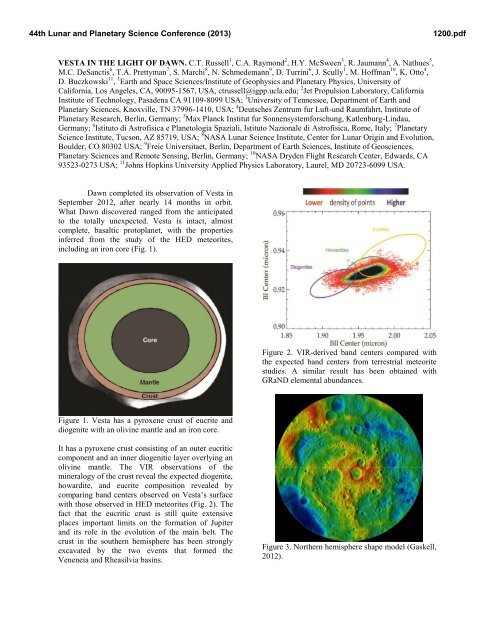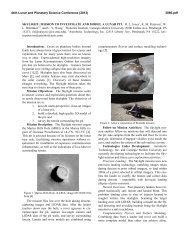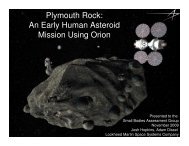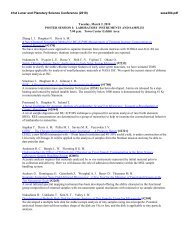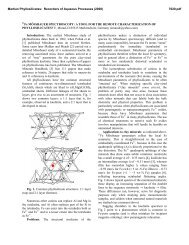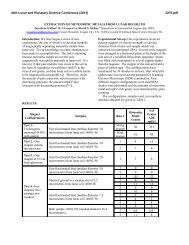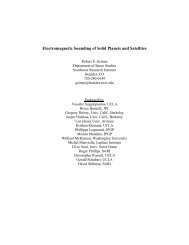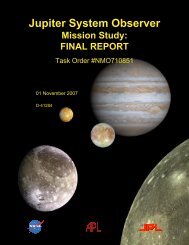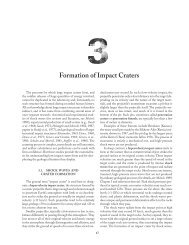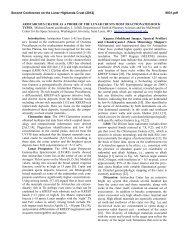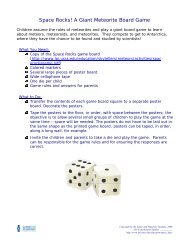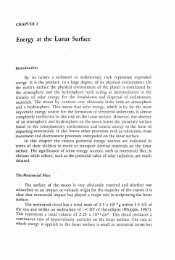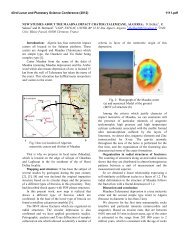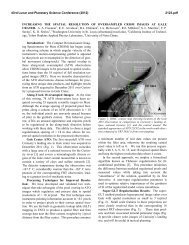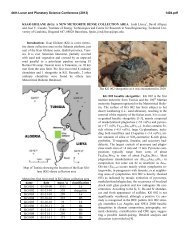1200 - Lunar and Planetary Institute
1200 - Lunar and Planetary Institute
1200 - Lunar and Planetary Institute
You also want an ePaper? Increase the reach of your titles
YUMPU automatically turns print PDFs into web optimized ePapers that Google loves.
44th <strong>Lunar</strong> <strong>and</strong> <strong>Planetary</strong> Science Conference (2013)<br />
<strong>1200</strong>.pdf<br />
VESTA IN THE LIGHT OF DAWN. C.T. Russell 1 , C.A. Raymond 2 , H.Y. McSween 3 , R. Jaumann 4 , A. Nathues 5 ,<br />
M.C. DeSanctis 6 , T.A. Prettyman 7 , S. Marchi 8 , N. Schmedemann 9 , D. Turrini 6 , J. Scully 1 , M. Hoffman 10 , K. Otto 4 ,<br />
D. Buczkowski 11 , 1 Earth <strong>and</strong> Space Sciences/<strong>Institute</strong> of Geophysics <strong>and</strong> <strong>Planetary</strong> Physics, University of<br />
California, Los Angeles, CA, 90095-1567, USA, ctrussell@igpp.ucla.edu; 2 Jet Propulsion Laboratory, California<br />
<strong>Institute</strong> of Technology, Pasadena CA 91109-8099 USA; 3 University of Tennessee, Department of Earth <strong>and</strong><br />
<strong>Planetary</strong> Sciences, Knoxville, TN 37996-1410, USA; 4 Deutsches Zentrum fur Luft-und Raumfahrt, <strong>Institute</strong> of<br />
<strong>Planetary</strong> Research, Berlin, Germany; 5 Max Planck Institut fur Sonnensystemforschung, Katlenburg-Lindau,<br />
Germany; 6 Istituto di Astrofisica e Planetologia Spaziali, Istituto Nazionale di Astrofisica, Rome, Italy; 7 <strong>Planetary</strong><br />
Science <strong>Institute</strong>, Tucson, AZ 85719, USA; 8 NASA <strong>Lunar</strong> Science <strong>Institute</strong>, Center for <strong>Lunar</strong> Origin <strong>and</strong> Evolution,<br />
Boulder, CO 80302 USA; 9 Freie Universitaet, Berlin, Department of Earth Sciences, <strong>Institute</strong> of Geosciences,<br />
<strong>Planetary</strong> Sciences <strong>and</strong> Remote Sensing, Berlin, Germany; 10 NASA Dryden Flight Research Center, Edwards, CA<br />
93523-0273 USA; 11 Johns Hopkins University Applied Physics Laboratory, Laurel, MD 20723-6099 USA.<br />
Dawn completed its observation of Vesta in<br />
September 2012, after nearly 14 months in orbit.<br />
What Dawn discovered ranged from the anticipated<br />
to the totally unexpected. Vesta is intact, almost<br />
complete, basaltic protoplanet, with the properties<br />
inferred from the study of the HED meteorites,<br />
including an iron core (Fig. 1).<br />
Figure 2. VIR-derived b<strong>and</strong> centers compared with<br />
the expected b<strong>and</strong> centers from terrestrial meteorite<br />
studies. A similar result has been obtained with<br />
GRaND elemental abundances.<br />
Figure 1. Vesta has a pyroxene crust of eucrite <strong>and</strong><br />
diogenite with an olivine mantle <strong>and</strong> an iron core.<br />
It has a pyroxene crust consisting of an outer eucritic<br />
component <strong>and</strong> an inner diogenitic layer overlying an<br />
olivine mantle. The VIR observations of the<br />
mineralogy of the crust reveal the expected diogenite,<br />
howardite, <strong>and</strong> eucrite composition revealed by<br />
comparing b<strong>and</strong> centers observed on Vesta’s surface<br />
with those observed in HED meteorites (Fig. 2). The<br />
fact that the eucritic crust is still quite extensive<br />
places important limits on the formation of Jupiter<br />
<strong>and</strong> its role in the evolution of the main belt. The<br />
crust in the southern hemisphere has been strongly<br />
excavated by the two events that formed the<br />
Veneneia <strong>and</strong> Rheasilvia basins.<br />
Figure 3. Northern hemisphere shape model (Gaskell,<br />
2012).
44th <strong>Lunar</strong> <strong>and</strong> <strong>Planetary</strong> Science Conference (2013)<br />
<strong>1200</strong>.pdf<br />
Most of the northern crust is older than the southern<br />
basins but it appears to have received a partial<br />
resurfacing during the southern basin-forming impact<br />
events (Fig. 3). The cratering record has been found<br />
to be in production down to about 2 km crater size on<br />
~3.8 Ga old surfaces, although crater frequencies are<br />
higher than the lunar equilibrium distribution (Fig. 4).<br />
The cratering record is consistent with some of the<br />
models of the evolution of the asteroid belt <strong>and</strong><br />
planetary migration theory <strong>and</strong> puts important<br />
constraints on the history evolution of the solar<br />
system. The 110-km radius iron core may have aided<br />
Vesta’s survival through its heavy bombardment<br />
early in its history. The surface shows evidence for<br />
the cross solar system transport of volatiles <strong>and</strong><br />
carbonaceous material. The study of HED meteorites<br />
presaged those discoveries (Fig. 5, Fig. 6). The<br />
biggest surprises have come from a detailed highresolution<br />
study of the surface; the discovery of pits<br />
as opposed to craters (Fig. 7); the different styles of<br />
gully formation (Fig. 8); <strong>and</strong> discovery of odd crater<br />
morphologies.<br />
Figure 4. SFD near Veneneia antipode on north.<br />
Figure 7. Pits on Mars (top) <strong>and</strong> Vesta (bottom).<br />
Figure 5. A quartz veinlet (Tremain et al., 2004).<br />
Figure 6. Carbonaceous clasts (Herrin et al., 2007).<br />
Figure 8. Two types of gullies found on Vesta.


